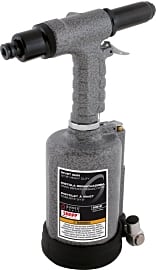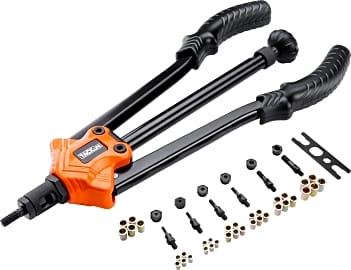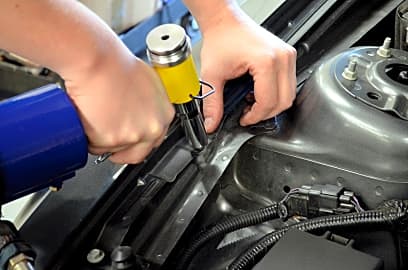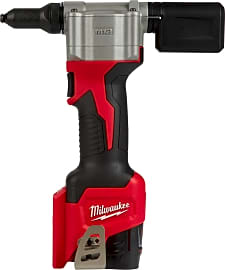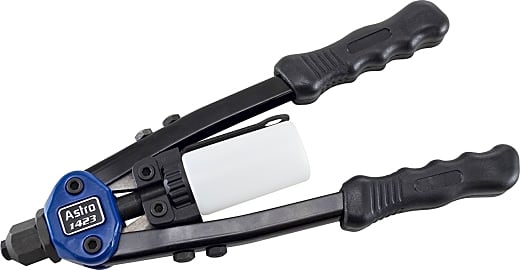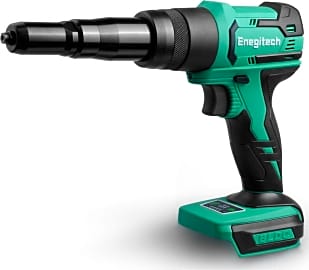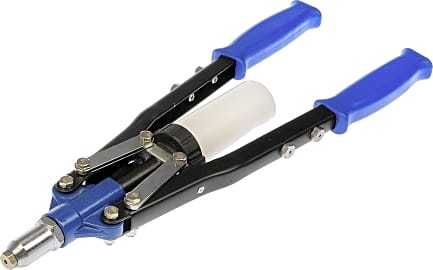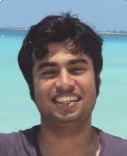The 10 Best Rivet Guns

This wiki has been updated 44 times since it was first published in March of 2015. Whether you’re gearing up for your next do-it-yourself project or preparing to take on a professional contracting job — anything from aircraft construction to home building — you’re bound to find a rivet gun on this list that will make your work go quicker and easier. We've included both pneumatic and manual models at various price points that should be suitable for any budget. When users buy our independently chosen editorial choices, we may earn commissions to help fund the Wiki.
Editor's Notes
August 13, 2020:
The vast majority of riveters on the commercial market are made for blind rivets, or rivnuts of a certain thickness. The term ‘pop rivets’ has been commonly adopted to refer to blind rivets, though POP® rivets are a brand of blind rivets, much in the same way that Hoover is a brand of vacuum cleaners. The varieties of blind riveters you’ll find on the market fall into 3 categories - manual, pneumatic, and cordless. Pneumatic guns are widely used in industrial applications for the power that they can deliver, though cordless options appear to be on the rise because they offer an equally powerful yet more compact alternative to their pneumatic counterparts.
While the Milwaukee M12 was a relatively impressive option when it came out a few years ago, I wanted this list to include some more cordless options to better reflect market changes and upcoming trends; so, I’ve added the relatively new Makita XVR01T, as well as the Enegitech Cordless as a budget alternative. The latter can actually work with 18V Makita LXT batteries – the same batteries that the XVR01T uses. You do have to buy the battery separately, though this model offers a lot of value at a relatively low cost, so I don’t really see this as a major upset.
Makita actually released two models – the XVR01T for rivets up to 4.8 mm, and the XVR02T which adds 6.0mm and 6.4mm, and is a little slower because its more powerful, and has a slightly longer stroke too – and I thought of including both as special honors, but I’ve ultimately decided to include only the XVR01T in our list. These models may seem quite a bit pricier than a handheld riveter or even other commercially available pneumatic or cordless options, but they can make a huge difference in demanding industrial applications where you have to set 100’s of rivets a day.
Obviously, the power with these is a factor worth mentioning, as it can significantly improve your working speed; however, durability is also worth a mention as these models will for the most part pay for themselves and will very likely outlast multiple budget alternatives. There are some other high-end cordless guns from brands like Lobster (Japanese), Gesipa (German), Avdel and Atlas, but they're quite hard to get and/or not particularly special. However, I do think that more of these brands will move more into the mainstream with future models, as cordless riveters gain a greater foothold.
Finally, the type of gun you choose will suit your particular application, as will the type of rivet you choose. Regardless of the rivet material you choose for your application, it can be sensible to make sure that the mandrel material is the same as the rivet – this minimizes the risk of corrosion and weakening of the rivet material, which may have been in storage for a long time. It seems like a trivial thing, but it can make a difference.
May 02, 2019:
Upon reviewing the list, three items raised significant red flags in terms of quality. We found several reports that rivets tend to get stuck in the Tekton 655, which results in the frustrating process of trying to remove the fastener (in addition to the tool not functioning properly). As for the Arrow RHT300, it appears to be cheaply built with thin metal, leading to durability issues. Users indicate that the Stanley MR100CG is essentially unusable, jamming constantly and eventually breaking in many cases. All three have been removed from the list.
Looking into the Tacklife Tool, people seem truly impressed with the quick pumping action and the simple ability to replace riveting rods without any tools. We decided to increase its ranking. On the other hand, we docked the Dorman 743-100 a few spots after discovering some users that were unsatisfied with the amount of leverage it provides.
We attempted to cater to a wide audience with our three new additions, incorporating a hand riveter, a pneumatic model, and a battery-powered tool. Users of the Sunex SX1819T in particular seem thrilled in its ability to handle extensive daily use without breaking down. The Milwaukee M12 is a comprehensive kit, containing a carrying bag, a charger, and two batteries in addition to the tool itself.
Understanding Riveting
The riveting process uses force to push together a rivet and a rivet head.
Riveting is a method for making a permanent mechanical joint between two structures. Unlike bolts, they cannot be disassembled without breaking the rivet. The riveting process uses force to push together a rivet and a rivet head. This causes a deformation of the tail and forms a shape that is capable of firmly holding together two plates.
Rivets have three main classifications, each of which can be further broken down into distinct styles. Solid rivets are the original type of rivet, but in modern times these are commonly replaced by welding or brazing. Solid rivets are available as a round head, countersunk, or oval countersunk design.
Round head rivets will form a joint that has a small round head sticking out slightly from the joined plates. Countersunk rivets create a perfectly flush joint, while oval countersunk rivets have less protrusion than round head rivets and can be used in heavier load applications than countersunk rivets.
Hollow or blind rivets are used widely in aircraft and electronics industries. They are easier to work with than solid rivets and have the fastest rate of installation. Unlike solid rivets, blind rivets can be installed from a single side. They are also available in round head or countersunk head designs.
Tubular rivets have a hole which allows a wire to be inserted through the rivet. They are often used in electrical engineering and the toy industry and are ideal for applications where metal needs to be joined with other softer materials like leather or plastic.
Rivets can be used to create lap joints or butt joints. A lap joint is used when the plates being brought together are overlapping each other. To create a lap joint, a rivet is inserted through the overlapping sections. Butt joints must be used when the plates cannot be overlapping. In this case, a cover plate of some kind is set over the two plates, which are butted up to each other.
Different Types Of Rivet Guns
A rivet gun is the tool used to drive rivets through plastic or metal plates, typically to conjoin two pieces. They are also sometimes called pneumatic hammers and come in many different shapes and sizes. Those used for structural steel applications are large and require the use of two hands, while others used in electrical engineering can be easily operated with one hand. The majority of industrial rivet guns are pneumatically powered, but there are hand powered options which can be a good choice for home use on smaller projects.
There are five main types of rivet guns commonly available; slow-hitting, fast-hitting, corner, squeeze, and pop.
There are five main types of rivet guns commonly available; slow-hitting, fast-hitting, corner, squeeze, and pop. A slow-hitting rivet gun strikes several times as the trigger is pressed, with a standard repetition rate of somewhere around 2,000 blow per minute. Fast-hitting rivet guns are best for soft rivets and strike a high number of lightweight blows, anywhere from 3,000 to 5,000 blows per minute. The quick repetition makes them harder to control and less popular than slow-hitting guns.
Corner rivet guns are designed for use in tight spaces and are generally more compact than other types. Instead of a direct drive, corner rivets are driven at a right angle. Squeeze rivet guns use an air-powered compression action rather than a continuous hitting motion, like fast and slow-hitting riveters perform. They apply pressure to the rivet from both sides and are capable of producing very uniform rivet sets. They can also be used for applications where rivets are needed close to the edge of a plate.
Pop rivet guns are handheld options that utilize the user's grip strength to set rivets instead of pneumatic power. They are only suitable for thin sheets of metal and plastic and are rarely used for industrial applications.
Tips For Proper Riveting
While proper riveting technique often depends on the type of rivets and the type of gun you are using, there are a few tips that apply to every type of riveting. Always use the proper type of rivet gun and rivets for your application. If you are riveting weight-bearing structural steel plates, not only would it be very difficult to use a handheld option, but if you were to succeed in setting any rivets, they wouldn't have the required holding power.
Before starting any riveting job, research the best type of gun and rivets for the intended application.
If you are creating rivets in something that requires wires to be passed through the plates being fastened, make sure to use tubular rivets otherwise you will wind up having to drill separate holes for the wires, creating uneccessary work. Before starting any riveting job, research the best type of gun and rivets for the intended application.
Once you've chosen a device to use, the next step is picking the right sized rivets and joint materials. It is vital to use the correct size rivets and mating joint elements. If your rivets are too thin, they won't be strong enough, and if they are too large, you will be required to drill overly large holes which can compromise the integrity of the joined plates.
The rivet length is also an important factor to take note of. Rivets should be long enough to completely pass through the joint, but no so large that they stick out overly far. If they are too short, you will not be able to close your rivets. If they are too long, the rivets will close but won't be tight enough, resulting in loosely joined plates that may slide or rattle.


